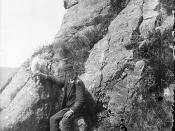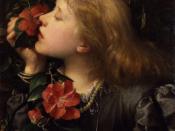"The Lamp at Noon" is a short story that focuses on the reality of the desiccated, secluded, and expansive prairies. Set on the haunting Canadian prairies, weather emulates the emotions of Ellen, a housewife desperate for freedom of the dustbowl lifestyle. The authority of wind and dust seem to taunt Ellen and her husband, Paul, into desperation. Ross applies symbolism across the pages of "The Lamp at Noon" to inform the reader of the lonely emotions that are wrought by the desolate and barren prairies.
In Ross's short story the use of three important symbols is crucial. The first is the lamp, which on the whole embodies the spirit and optimism that Ellen feels towards her marriage to Paul. " [Ellen] lit the lamp," (7) just prior to her much anticipated lunch with Paul, where she would argue her sentiments about eradicating their lives of "[t]histles and tumbleweeds" (10).
Before lunch Ellen seemed confident that, this time, Paul may finally understand her growing concerns about the prairies - she lights the lamp, just as she lights her hopeful feelings. As Ellen waits for Paul by the window the "lamp reach[es] out through the open door" (7) towards Paul, subsequently it is Ellen who is reaching out to Paul. In the course of the couples fiery discussion "the lamp [ ] threw strong lights and shadows on their faces," (9) denoting Ellen's dimming hopes that their conversation will be as optimistic as she. Paul was "compelled by his anxiety"(14) to return to the house, after exiting their discussion abruptly, to resolve his matters with Ellen. But his return was not greeted with Ellen; it was greeted with Ellen's vanished hope that Paul would ever understand her - "the lamp [was] blown out" (16). Ellen's hopes and confidences...


